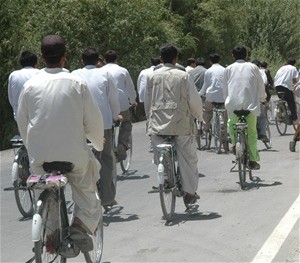Home » Reports & Data » Progress » Transforming Lives » New Road Increases Access to Basic Facilities

Every day over 400 bicyclists ride over the Pul-e-Alam road south of Kabul. Many of the riders are students going to-and-from school.
Idrees Ilham/USAID/Afghanistan
New road cuts travel time and increased access to reach schools, clinics and markets
1 JUNE 2006 | PUL-E-ALAM, LOGAR PROVINCE
Road reconstruction is a high priority for the Government of Afghanistan. The Pul-e-Alam road to the Kabul Kandahar Ring Road was a rough trail that passed over rugged hillsides, gullies and creeks. The travel time was slow, expensive, dangerous and unreliable.
Road reconstruction is a high priority for the Government of Afghanistan. The Pul-e-Alam road to the Kabul Kandahar Ring Road was a rough trail that passed over rugged hillsides, gullies and creeks. The travel time was slow, expensive, dangerous and unreliable.
The new 35 km Pul-e-Alam road winds through a fertile valley, rich with farming activities. It connects to the Kabul-Kandahar Highway, cutting the travel time from 2 hours to 40 minutes. Over 200,000 people in the vicinity of the Pul-e-Alam road benefit from the new road.
Road reconstruction in Afghanistan has provided increased access to education and health care, improved travel, greater security, and reactivated the agriculture sector. The decrease in travel time allows farmers to get their produce to market before spoiling. Roads also provide an economic avenue for national and international trucking across the country.
This is part of the United States Agency for International Development’s (USAID) secondary roads reconstruction program to provide a much needed infrastructure to Afghan communities. It is also part of a larger master plan by the Government of Afghanistan to reconnect the internal land bridge and rebuild the transport sector. Afghanistan has the capability of connecting Central and South Asia to the ports of the Indian Ocean and greater Asia.
The Afghan government, with the help of USAID, the United Nations Office for Project Services (UNOPS), and the Louis Berger Group (LBG), is able to provide quicker access to services and cities that were previously difficult to reach. Locally available materials for the construction of this $10.1 million road were used as much as possible. Hundreds of Afghans received training, gained technical expertise, and made up a large portion of the labor force with approximately 50% of the road work subcontracted to Afghan firms.







Comment
Make a general inquiry or suggest an improvement.